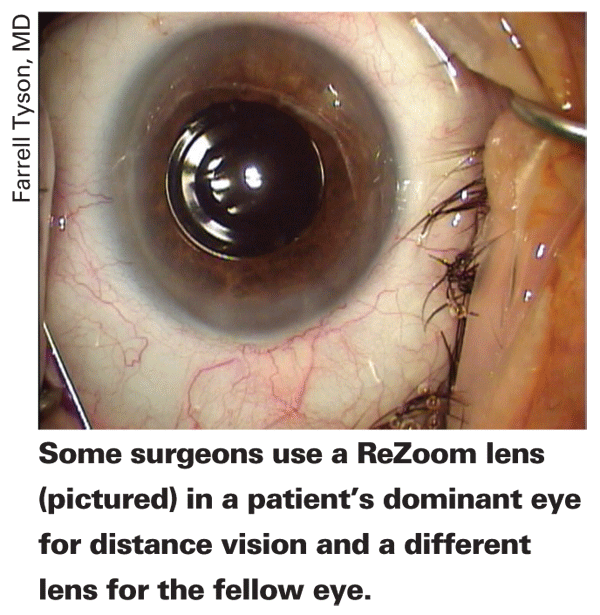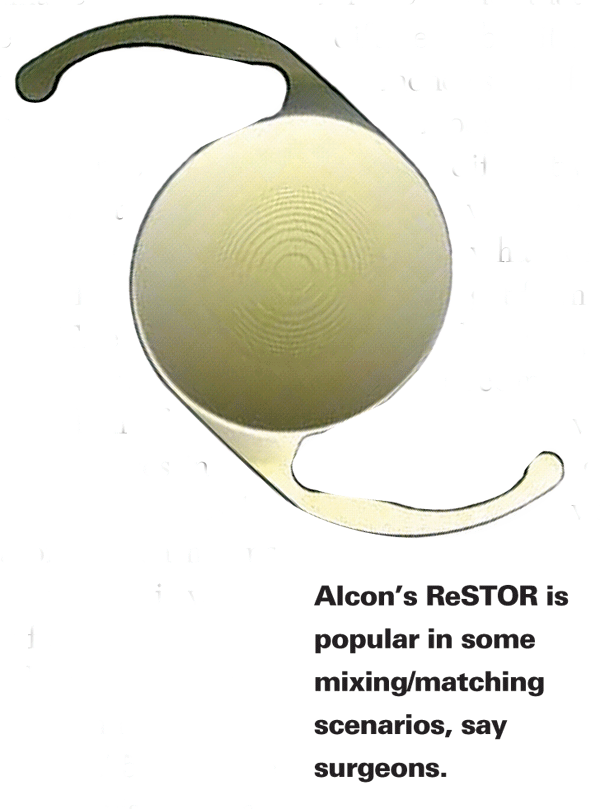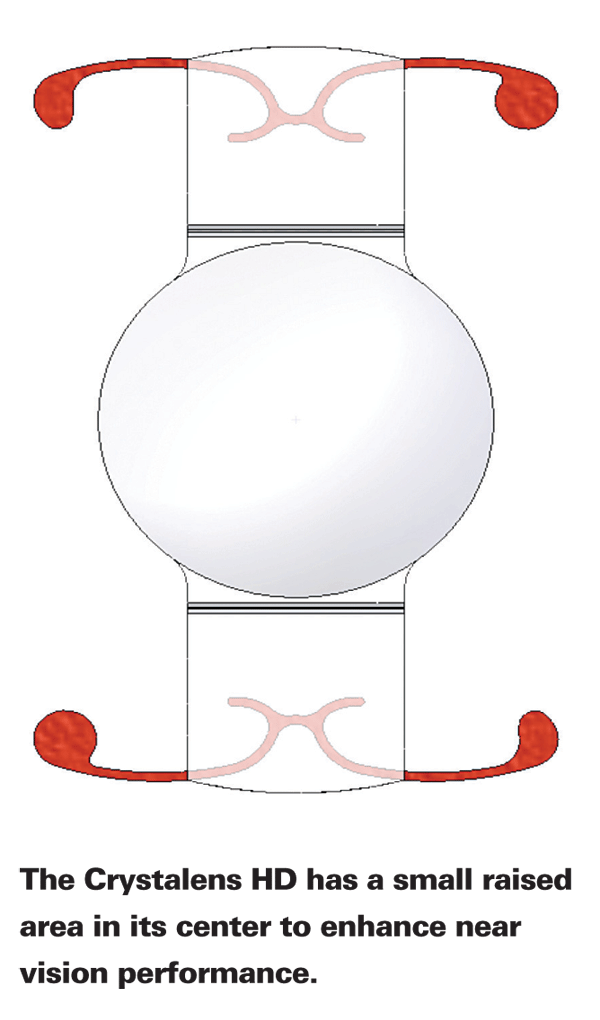When presbyopic lenses such as ReSTOR and ReZoom were first approved, people didn't know exactly what to expect from them in their daily surgical practice. Some surgeons may have overestimated the benefits they'd confer to presbyopes, while others may have had a dimmer view of their usefulness. The truth, as always, was somewhere in between. Now, a couple of years later, surgeons are much more experienced in these implants, and know how to maximize their advantages while minimizing their disadvantages with the right patients. Here's what several experts think about the devices they use and a look at the characteristics of the newest entrant in the field, the Tecnis multifocal lens.
The Best Lens for the Job
Armed with a knowledge of the different presbyopic lenses, surgeons can tailor a lens to a particular patient.
"I think all of the lenses have roles in various patients," says

Sarasota
Dr. Lahners' second approach is for pilots, professional drivers or patients with very small or very large pupils. "For these patients, we use the Crystalens HD in the dominant eye, then reassess the non-dominant eye and induce a little bit of monovision with another Crystalens HD or use a diffractive lens like a ReSTOR," he says. "I do this because though the ReZoom is a good lifestyle lens, if the patient has small pupils he's not going to get the middle-vision zone of the lens. So, in a 2- or 2.5-mm pupil, all you're really giving someone is an expensive monofocal distance lens. However, someone with very small pupils will do well with the Crystalens HD because he's also going to benefit from that diffractive element of having a small pupil.

"In people with large pupils, the opposite is true," Dr. Lahners adds. "If they have traumatic mydriasis or are very young, they may get excessive halos from the outer bands of the ReZoom lens. That would also be an argument for Crystalens HD in these patients. The same goes for pilots. Though I've implanted all of the types of multifocal lenses in pilots, if a pilot has to have a Class 1 medical qualification, which means 20/20 acuity in both eyes, it would probably be easier for him to qualify with a single-vision lens, and we'd use the accommodative lens in such a patient. If I use a mini [0.75 D in the non-dominant eye] monovision in this patient, he'll still need glasses to fly. If he doesn't want glasses to fly, I'll target both eyes for emmetropia and caution him that he'll most likely still need to wear some reading glasses depending on the light and what he's trying to read."
Surgeons say they feel the Crystalens HD is yielding better near vision than its predecessors, thanks to a modification of the center of the optic. "There's a 1.5-mm diameter bump in the center," explains
Dr. Waltz will also mix lens types if he thinks it will benefit the patient. "I'm a believer that mixing and matching makes a lot of sense in most patients," he says. "None of these lenses is perfect, so if you can get a combination of effects, that seems to work better. You have to prepare the patient for the reality that the vision will be different, but it's no different than monovision. If you put an accommodating lens in one eye and a diffractive in the other, it works very well, because whatever symptoms you get from the diffractive can be suppressed by the accommodating lens and wherever you don't get strong reading vision from the accommodative lens you can get it from the diffractive. So, my default combination is an accommodative lens in one eye and a diffractive in the other."
Though surgeons say explants are inevitable with any of the lenses, there are steps you can do to minimize them.
"It depends a little bit on how aggressive you are in actually putting them in," says Dr. Waltz. "If you're conservative in whom you choose, you almost never have to take one out. My explantation rate is a lot less than one in 100. But if you get a little more aggressive, you might have to take one out. By conservative I mean you never put one in a myope, and always put it in a hyperope that's +2 D or more. These are the easiest people to make happy. The next group is the high myopes, while the people who are emmetropic or slightly myopic are very difficult to make happy."
The ReSTOR +3 D Arrives
Alcon recently received U.S. Food and Drug Administration approval for a version of its ReSTOR lens with a 3-D add, a little less than the original 4-D ReSTOR. The lens was scheduled to ship to surgeons in mid-January, and physicians are still determining how it may best be put to use in their practices. "The 3-D add moves the working distance away from the patient," says Dr. Waltz. "With the 4-D add, patients would complain that the working distance was a little bit close. The problem is, if the patient is even a little bit hyperopic with the 3-D ReSTOR, the working distance is going to be 60 cm or 70 cm or more away, and that's going to be a problem. So, one of the things we'll have to remember is, with the 4-D ReSTOR, you want to hit
Marshalltown

Though the new ReSTOR isn't in widespread use just yet, there is some speculation that it may cause more dysphotopsias than the 4-D version. "The 3 D will have a few more adverse symptomatologies than the 4 D, because the 3 D has less distance between the distant and near images, while the 4 D splits them farther apart," says Dr. Waltz. Some, however, think this remains to be seen. "I haven't seen any data that suggest that's occurring," says Dr. Lahners. "And from the information I've received from the company, that doesn't sound like it's been an issue on the test bench. But I think we'll know more when we see and use the lens. That's always the ultimate test: seeing the lens in action and actually working with patients who have the lens. That's what drives clinicians."
The Tecnis Multifocal
AMO's Tecnis multifocal intraocular lens received FDA approval just last month, so it's worth a look in terms of how it might fit into your practice. Here is a discussion of the lens and the results of the patient study, which compared the results of 121 Tecnis patients to those of 122 monofocal lens recipients. At one year, 114 multifocal patients were available for follow-up.
The Tecnis has an aspheric anterior surface and a full diffractive posterior surface. It's available in both silicone (with a square edge) and acrylic (with the OptiEdge) versions. The optical add is 4 D.
In the FDA study, patients were able to read 20/30 print size at 148 words per minute vs. a control group of monofocal patients who could read 20/63 print at 117 words per minute, a difference that was statistically significant. Ninety-three percent of the Tecnis MF patients could see 20/25 or better at distance and 20/32 or better at near with distance correction. One patient (0.8 percent) required pupilloplasty and bilateral lens explantation due to halos and glare; three (2.4 percent) needed lens exchange to correct the power and one (0.8 percent) had an exchange because he'd received the wrong type of lens.
"The unique property of the aspheric Tecnis lens is that it's a full-optic diffractive lens," explains Dr. Waltz, who presented Tecnis MF data at the most recent
Though new technologies will arrive and change the state of lenses, for now surgeons say they can successfully use the devices they have in the right patients. "As much as everyone likes to say that multifocal lenses are on their way out, I have to say the best results we've achieved to this day are with multifocal platforms and some of our happiest patients are multifocal patients," says Dr. Lahners. "I think they're here to stay until we have a lens that corrects distance and provides an accommodative amplitude that's similar to a natural lens."
Dr. Davis is a consultant for Bausch & Lomb. Dr. Lahners consults for AMO, Alcon and Bausch & Lomb. Dr. Davison is a consultant for Alcon. Dr. Waltz receives royalties from Bausch & Lomb and research support from AMO.











